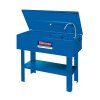The literature for "Irontite Thoro-Flush" says it will unplug cooling systems that are completely blocked. It also says it can be used to clean blocked oil coolers on diesel applications (off the vehicle), and other similar uses. And the instructions say it does not take long. Usually that means it is a caustic agent, so I looked further.
According to the SDS, "Irontite Thoro-Flush" is basically TSP (trisodium phosphate). And the bottle says it comes as a powder, which is how TSP is usually sold. TSP was a common household cleaning product for decades and it was very inexpensive; used to clean walls before painting, decks, equipment, floors, etc. It is strong but I don't think it is really caustic (need to research it more). I read once where it was a decent degreaser for engines, etc, but I never tried it; I wanted to several years ago but TSP was no longer available on the shelf in Calif (typical CA regulations). A "substitute" product was labeled as TSP but wasn't the same and I doubt it would work (the "safe" versions of anything usually don't). However it might still be available in other states, or perhaps it has since been deregulated in CA, or maybe it can be ordered online regardless where you live (I've never quite understood that one). Might be worth getting some and experimenting with it for multiple uses, including cleaning the cooling system.
https://en.wikipedia.org/wiki/Trisodium_phosphate


